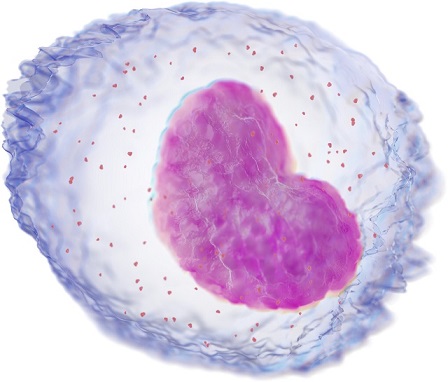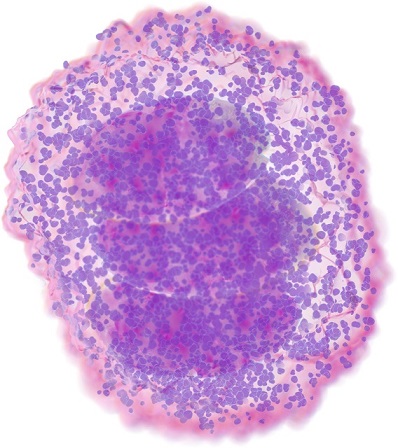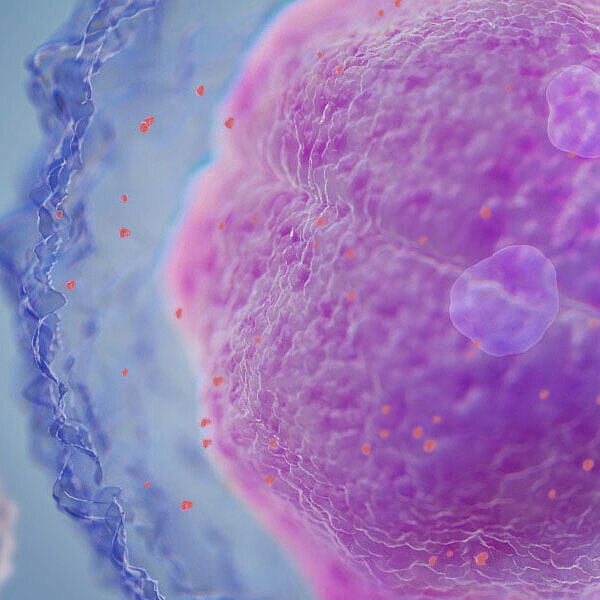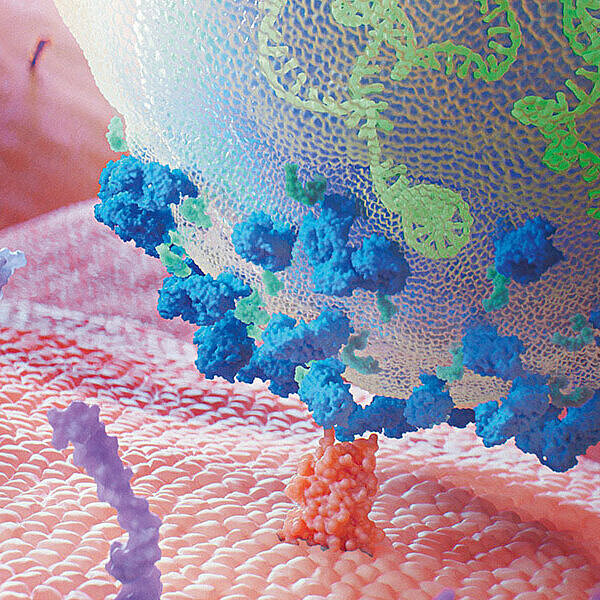Globules blancs
Les globules blancs sont un groupe de cellules variées qui proviennent de différentes cellules précurseurs. Bien que les fonctions propres à chaque catégorie de globules blancs sont très diverses, toutes visent à défendre l'organisme contre des agents extérieurs au sens large. Les globules blancs myéloïdes sont produits dans la moelle osseuse. Le développement des cellules lymphoïdes n'est cependant pas limité à la moelle osseuse et se produit dans des organes lymphoïdes primaires et secondaires.
Le nombre total de globules blancs chez les adultes en bonne santé se situe à peu près entre 4 et 12 x 106 cellules/µL, et les lymphocytes et les neutrophiles constituent la majeure partie de ces cellules. Les éosinophiles, les basophiles et les monocytes se retrouvent en nombres bien moindres chez les personnes en bonne santé. La numération absolue de chaque catégorie de globules blancs dans le sang périphérique a une importance clinique et donne davantage d'informations que la numération relative donnée en pourcentage. Les pathologies des globules blancs affectant soit la lignée myéloïde, soit la lignée lymphoïde, peuvent être le résultat de maladies réactives et non réactives (malignes). Des évolutions réactives sont observées dans les maladies infectieuses ou inflammatoires, tandis que des altérations malignes sont le signe de leucémies, de lymphomes et d'autres malignités hématologiques.
Pour distinguer les différentes maladies liées aux globules blancs, il est essentiel de déterminer tout à la fois leur nombre, leur nature exacte et leur stade de maturité. L'analyse hématologique automatisée est une composante cruciale du processus de diagnostic et aide à identifier la présence d'une maladie en fournissant une numération précise des cellules et en soulignant les populations de cellules en trop grand nombre. Dans les maladies liées aux globules blancs, il est difficile d'établir le bon diagnostic et cela implique d'envisager toutes les informations disponibles grâce à la numération formule sanguine, aux tests morphologiques, au phénotypage immunologique et à d'autres tests.
Neutrophils
Neutrophils belong to the granulocytes, which are characterised by the presence of granules in their cytoplasm. They play an important role in immune defence and are the first immune cells to arrive at a site of inflammation – usually within minutes. This happens through a process known as ‘chemotaxis’. Neutrophils can phagocytose other cells which seem harmful to the organism, such as bacteria. Yet they will not survive this act: pus consists mainly of dead neutrophils and digested bacteria.
Acute infections commonly cause various degrees of neutrophilia due to the release of segmented neutrophils and bands from the bone marrow and marginating pool. This reactive neutrophilia is often associated with the presence of toxic granulation, Doehle bodies, cytoplasmic vacuoles and elevated levels of leucocyte (neutrophil) alkaline phosphatase (LAP).
An increased neutrophil count can also be found due to primary abnormalities in the regulation of bone marrow neutrophil production, or physiologically in non-pathological situations, e.g. after stress or in smokers.
The absolute and relative neutrophil count can provide some information for diagnosis and monitoring of infections and is also watched during chemotherapy.
Lymphocytes
Lymphocytes defend the organism against infection by distinguishing the body’s own cells from foreign ones. Molecules recognised by the body as foreign are known as antigens. Each lymphocyte is only stimulated by one specific antigen. When lymphocytes recognise this antigen, they produce chemicals to fight it.
There are three main types of lymphocytes: B cells, T cells and natural killer cells. Although ‒ compared with other white blood cells ‒ all lymphocytes are small and round without granules, there is a large variety of different subtypes, and distinguishing between them morphologically is tricky.
Reasons for an increased lymphocyte count include infection or inflammation, as well as certain types of malignancies, especially haematologic malignancies. In addition to giving an absolute and relative lymphocyte count, several flags on Sysmex analysers can point to suspicious lymphocytes for which presence a follow-up test should be performed.
Monocytes
Monocytes play a key role in the immune response. They can quickly move to infection sites and differentiate into macrophages and dendritic cells to provoke an immune response. Cells of the monocyte-macrophage system can engulf foreign particles and break them down to antigens, which they can then present on their surface.
Automated monocyte counts are available as the ratio of monocytes to the total count of white blood cells, or as an absolute count. An increased monocyte count may be indicative of various disease states, e.g. chronic inflammation or infection, but may also occur in malignant diseases such as chronic myelomonocytic leukaemia.
Eosinophils
Like neutrophils, eosinophils belong to the granulocytes because they are filled with granules containing different enzymes. Eosinophils are best known for their roles in anti-helminth immunity and allergic diseases including those affecting the skin, respiratory system and gastrointestinal tract. They can also move and phagocytose particles. Since they kill helminthic parasites by releasing certain cytotoxic enzymes to amplify the inflammatory response and are involved in hypersensitivity reactions, an increased eosinophil count is most likely associated with parasite infestation or allergy. However, eosinophilia can also point to malignant diseases as it is evident in some types of neoplasia.
Basophils
Basophils are the white blood cells least represented in peripheral blood; they also belong to the granulocytes. Like with eosinophils, an increase in the basophil count often ‒ though not always ‒ points to allergy or parasitic infections. Basophils are also present at the site of an inflammatory reaction. They seem to play a role similar to that of eosinophils in the defence against pathogens. Like eosinophils, they are recruited to the sites of allergic reactions and function together with mast cells as effector cells in complex processes such as chemotaxis or cell adhesion and fulfil an immunomodulatory role during allergic reactions.

![Granulopoiesis Neutrophilic Granulocyte [.NL-fr Netherlands (french)] Neutrophils](/fileadmin/media/f100/images/Scientific/Granulopoiesis_Neutrophilic_Granulocyte_01.jpg)
![[.NL-fr Netherlands (french)] Lymphocytes](/fileadmin/media/f100/images/Scientific/Lymphocytopoiesis_B_Lymphocyte.jpg)






